With the harvest finished on Monday and the ‘Gerbaude’ festival on the Tuesday, we started working for the château in the fermentation rooms on Wednesday. We were now to learn and be involved in the winemaking process with the grapes picked and sorted; the turning of grape juice into wine!
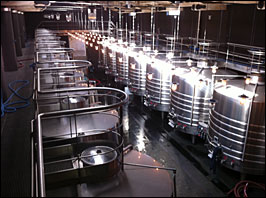
The Latour fermentation cellar
|
The vats are large steel tanks of varying size, designed specifically for winemaking (two of the vats available are wooden – but a very small proportion of the wine is fermented in these relative to production). Vats are divided by grape and vineyard (though more than one plot can be in one tank and a vineyard may also be split due to differing qualities within it). The wines are left to ferment in the tanks at specific temperatures; all monitored on a master board. Twice a day the wine is pumped. In the first few days this is with aeration, which is then limited towards the end. The wine is drained from the bottom of the vat either through an open container or straight back through to the top of the vat, where a sprinkler-style device spreads the wine evenly over the cap developed by skins and pips. The purpose of this is to reduce the density levels which are constantly analysed in a lab to ensure up to date accuracy. Once the goals are reached a team led by Frederic Engerer taste the wine and decide whether it is ready to be drained, or whether it needs to be left to rest for a few more days.
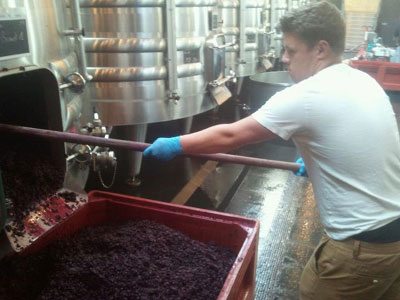
Ben Browett working hard to remove the large ‘cap’ of fermented grapes
|
Once the decision is made the wine is drained and the recently full vat has its front door opened. At this stage it will be entirely blocked by the aforementioned cap of skins, seeds and some juice. This must all be manually forked out of the vat (backbreaking work – take our word!) into containers which are then transported to a press, which once full presses the contents to make press wine, some of which is blended with the finished wine to give more body. There is a constant flow of data and lots of tasting going on at this stage of the process, and it is amazing to see just how much is monitored. With all the technology added to the skill of the winemaking team and the excellent terroir and grapes at Latour, we can be assured of a really high quality product. From the tastings of vat samples so far, Frederic is impressed with the quality, though it is always hard to be exact before the malolactic fermentation, as the malic acid is harsh on the palate before being converted to lactic acid. Frederic has said the Cabernet Sauvignon in particular (which is of course the majority grape of Latour’s Grand Vin) is exactly the profile that we have come to expect from the château, big, bold, very tannic at this stage, but with real depth. We finished our work as the press wine was going into barrel and all the wine was beginning its malolactic, softening stage.
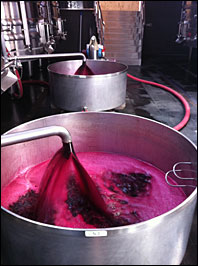
The wine being pumped through open containers for aeration
|
On Wednesday afternoon having finished our final morning at work we went to visit some more châteaux to further enrich our time and taste buds in Bordeaux. We first stopped at Haut Bages Libéral, a château placed just north of Latour between Pichon Comtesse Lalande and Lynch Bages. Caroline gave us a summary of the château’s history, including its tradition of still going to the Liberal party in the UK to give tastings once every two years. The vats, unlike the other châteaux visited so far, are half steel, and the other half made from thick cement. The benefits are evident in the thickness of the walls keeping the temperatures more constant, and they are also smaller, allowing greater selection and variety from vat to vat. We looked through the barrel cellar on our way to a tasting kindly organised for us. We started with the 2004, which was rich with dark fruit yet still perfumed on the nose. The palate was full bodied and round, carried by good crisp acidity. The tannins were quite soft, and the wine was certainly approaching drinking now, as secondary flavours and aromas like mushrooms were starting to integrate into the wine. The finish is full of concentrated brambly fruit flavour. We then tasted the 2003, which was hotter on the nose and surprisingly developed. Mushroom, white truffle and some red and black cherries dominated both the nose and the palate. The palate had good attack at the start, with good flavours warmth and roundness that faded slightly towards the finish, which was a little dry and shorter than the 2004. Still a good effort from the château in such a hot vintage of Bordeaux – this wine was not baked or jammy.
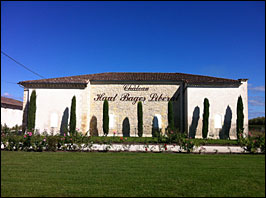
Picture perfect – The Chateau at Haut Bages Liberal
|
From Haut Bages we went to Léoville Barton where we were greeted by Lilian Barton-Sartorius, daughter of Anthony Barton. On the tour we saw Léoville Barton’s still wooden vats, another change from other châteaux. Being in the room gives a feeling of the history of winemaking. From history to innovation, we went to the Léoville Barton Barrel cellar where the cooling system avoids the dryness of air conditioning by running water at -2 degrees Celsius through pipes just below the ceiling. Having also toured round the cellars at Langoa Barton, where they are just filling the new oak barrels for the 2011 vintage, we went for a tasting of the two 2010s. Firstly Langoa Barton, which was cherry and bramble fruit on the nose with some spice. The palate had coarse tannins but open fruity and spicy flavours, with good concentration and racy acidity. The wine had good length, and will certainly be a great wine for the future. The Léoville Barton 2010 is a classic expression of Bordeaux wine. The nose needed a little coaxing as the wine is so young but revealed blackcurrants, vanilla pod, and bell pepper. The palate was really dense and concentrated with flavours that followed from the nose. The tannins were coarse and slightly chewy. The acidity on the palate gave the wine great lift and continued through to a spicy finish. This wine is still far too young, but it really is a wonderful expression of fresh and classic style Bordeaux.
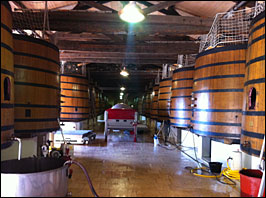
History in the wine-making at Chateau Leoville Barton
|
Finally we made a quick trip down to Palmer which is currently undergoing significant refurbishment to see Thomas Duroux, and taste the 2010s. While tasting he tells us that the production of 2011 will be down due to some sunburn in June and some other problems with extreme weather, but that the grapes picked were of a high quality and should make a good Palmer. We started with the 2010 Alter Ego de Palmer, which was warm, fruity and spicy on the nose, with ripe cherries and vanilla. The palate was rich and round, the tannins riper and softer than some other 2010s we have tasted. The finish is one of mulling spices on a good medium to long finish. The 2010 Palmer was certainly up a level from its little brother. The 53% Merlot, 40% Cabernet Sauvignon and 7% Petit Verdot wine is really dense and compact on the nose, spicy with brooding dark fruit. The palate continues the density of the nose with fresh yet ripe black fruits. There is an onset of tannin in the mid palate but they are softer and rounder in texture (a sign of the Merlot). The finish is long and with surprisingly well-integrated oak at this age. This is a sumptuous wine. We rushed off back to the apartment afterwards, to get ready for Stephen Browett’s arrival, who is coming to visit for the last two days of our time in Bordeaux. The details of the string of visits planned will follow shortly...
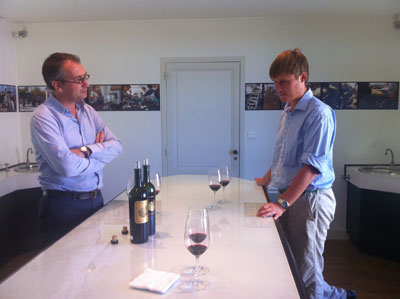
Double take – Thomas and Thomas muse over Palmer’s excellent 2010s
|
Having experienced the fermentation process we have both learnt a great deal and seen elements of the winemaking process neither of us knew existed, it has been really eye-opening. We cannot thank Latour enough for allowing us to be involved in the harvest and winemaking process for the past month. Seeing how the château runs and getting a ‘backstage’ view of what makes the First Growth such a success has been a real privilege that we are grateful to have seen. 2011 Château Latour will certainly be a special wine for both of us in the future, knowing that a little of our blood, sweat and tears (figuratively speaking, of course!) have gone into the final product. We will always know the weather and grape quality during harvest, the dates, and the time of fermentation. We are certainly looking forward to our first taste En Primeur...